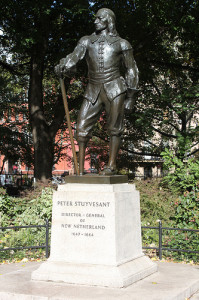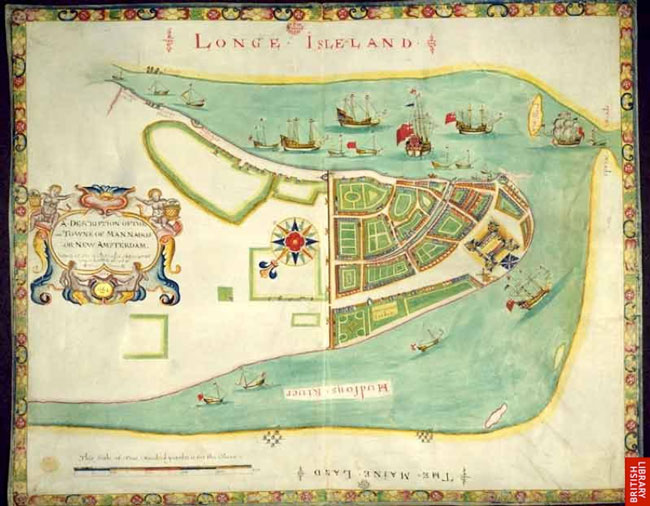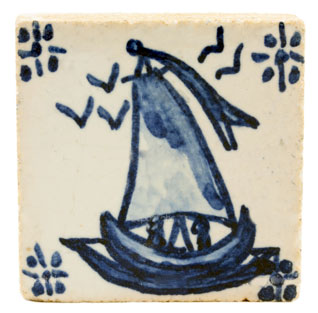Our Dutch ancestor, Thomas Lewis, was actually Scotch-Irish! He was born in Belfast but spent most of his life in New Amsterdam, a Dutch colony that later became New York City. He lived there during a turbulent period when the Dutch contested the territory with the Indians and the English. The Dutch founded New Amsterdam in 1626 when they purchased Manhattan Island from the Indians for 60 guilders, at about the same time that the Pilgrims were settling in Plymouth, Massachusetts. The Dutch colony grew and by the late 1650s encompassed western Long Island as well. New Amsterdam was a thriving mercantile town with strong shipping and trading interests. The population consisted of immigrants from all over Europe, particularly Holland and Great Britain, and was known for its religious tolerance. In 1664 the English captured the Dutch colony in a surprise naval attack. The Dutch recaptured the colony in 1673, but in 1674 the English re-took the area, permanently naming it New York City.
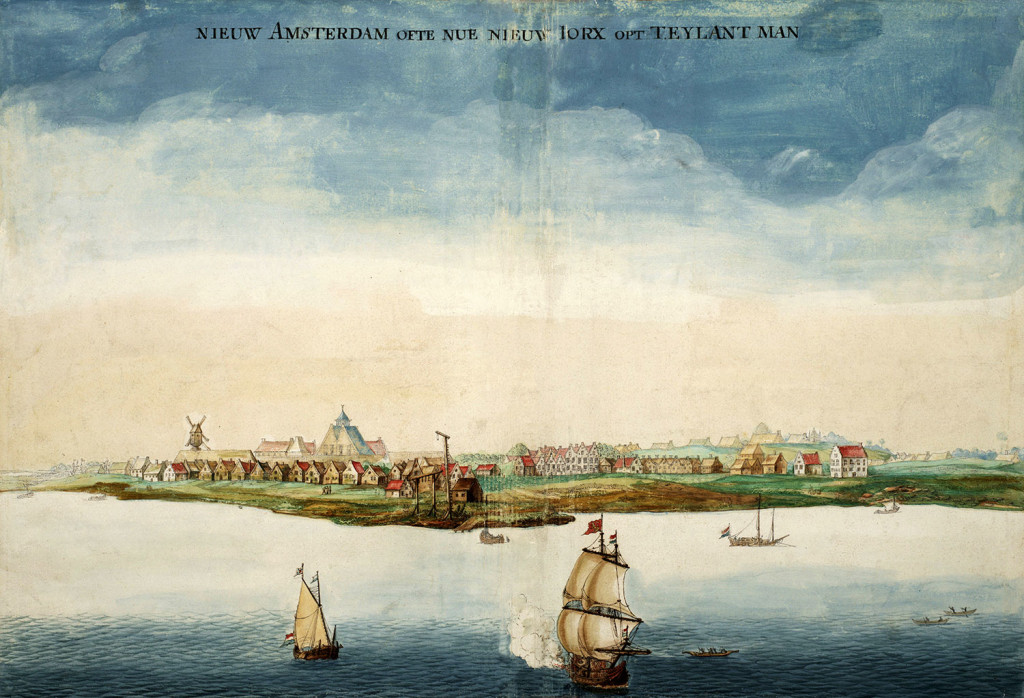
New Amsterdam as it would have been viewed by Thomas Lewis, arriving from Holland on the Blue Dove, 1656.
Thomas Lewis was born in Belfast, Ireland, about 1628. He immigrated to Holland with two of his sisters to avoid Cromwell’s wars in Ireland. The sisters died in Holland while still young women, after which Thomas departed for New Amsterdam. He sailed in 1656, on a ship called the Blue Dove, owned by the Dutch West India Company. On the ship’s register, he is listed as a carpenter; the company paid his passage in exchange for which Thomas agreed to stay in New Amsterdam for at least three years and work as a carpenter.
Lewis thrived in New Amsterdam and is mentioned in many early records, where his last name is written in Dutch form as Lodowycksen or Lievens. He went first to Albany, where he served out his term as a carpenter. After working off his obligation to the Dutch West India Company, he left carpentry to become a mariner. He married Geesje Barnets, a descendant of Dutch immigrants, in about 1661, and in 1663 he moved to New Amsterdam with his wife and one child. It is through Geesje, and Dutch brides of subsequent male Lewis descendants, that we trace our Dutch ancestry.
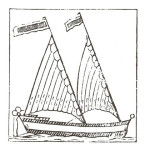
Pictured: a sloop, developed by the Dutch in Bermuda, displaying its typical triangular sails. 17th c. woodcut.
Also in 1663, Thomas Lewis served in the second Esopus Indian War, a conflict between Dutch farmers in Ulster County, up the Hudson River from New Amsterdam, and the Esopus Indians. By now he owned a boat, called a sloop, with which he transported troops to the battle site. Governor Peter Stuyvesant also used the sloop as his headquarters during the war.
Thomas Lewis prospered in the shipping business. He travelled around the New York coast, and went at least as far south as Virginia, to bring tobacco back to New York. He seems to have lived a colorful and event-filled life New Amsterdam, which at the time was essentially a frontier town. Court records of 1665 that mention him (usually as Thomas Lodowycx) give a flavor of life at that time.
- Lewis “states that he brought with him from the Virginias two hogsheads of tobacco for Mr. Petrus Stuyvesant, and that he will not receive them.” Lewis requested “that Mr. Stuyvesant’s wife shall be ordered to receive the same.”
- Lewis testified in court that “as he was proceeding with Abel Hardenbroeck and some women folk towards the Bouwery, he saw the defendant, Denys Isaacksen, draw the knife on the plaintiff, whom he pursued with many abusive and threatening words.”
- He was called into court for having been “out playing on the 13th of the month, being Sunday, contrary to the Placard.” He admitted he had been, but as he was not aware of any ordinance to the contrary, he was excused.
- On another court appearance that same day, “’Thomas Lodowycx, boatman’ stated that ‘when he went last to the South River he took an anker of brandy on freight from Capt Backer to deliver to Pieter de Rangiere.’ De Rangiere sent it back two hours later, saying it was half water. ‘He was thus obliged to bring the same back here, which he did and brought it back to said Backer, who refused to receive it, as he said, it was good brandy, which he himself brought on board. He requests therefore that the Court would order that he should do with it, inasmuch as he and all his crew will make oath, that the same was not adulterated by them.’” The court ordered him to pay Capt. Backer four beavers and costs for the brandy.
- He sued Hendricx Coustrie for freight to the South River, some of which Coustrie accused him of “’recklessly throwing overboard.’ On Nov. 21st he accused Coustrie ‘of being a liar and a rogue, and undertook to prove it. . . The aforesaid Lodowyx was fined for his abusive words.’ On Dec. 12th he ‘says it occurred through haste: declares he knows nothing of the plaintiff but what is honourable and virtuous.’ But he was fined 25 florins nevertheless.”
These court records reflect the frontier atmosphere of commercial transactions at the time. As the years went on, New York society became more stable and law-abiding. In 1668 Thomas and Geesje Lewis bought a house on William Street, adjoining Hanover Square, where they lived for the rest of Thomas’s life. They joined the Dutch Reformed Church, where all their children were baptized, except the first, who had been born in Albany.
By the early 1670s, Lewis was becoming a prominent and well-established citizen. On a list of “’the best and most affluent inhabitants of this city’ appears the name Thomas Lewis, whose property is valued at 6,000 florins. Only 16 other inhabitants of the city rank higher in the list. This shows that Thomas Lewis, from a humble beginning as a carpenter, was able by his trade as ‘mariner’ to amass a considerable fortune. . . .He was appointed Alderman of NY City by Gov. Andros Oct. 17, 1675, and was re-appointed in 1680 and 1682. In 1675-76 he was appointed chairman of a committee to survey vacant land, and to have casting vote in case of tie, ‘wee having conceived a good opinion of the fitnesse and ability of Mr. Thomas Lewis, Alderman.’”
Although Thomas Lewis never returned to Belfast, he maintained contact with relatives there, and his oldest son, Lodowick, spent time there as a young man.
Thomas Lewis died Sept. 28, 1684. He left his widow, Geesje, and five children, Lodowick, Barent, Leonard (our ancestor), Catharine, and Thomas. After his death, his widow became a baker and lived with her daughter, Catharine. The exact date of her death is not known, but it was somewhere between 1720 and 1725. At the time of her death, all her children were also deceased except for our direct ancestor, Leonard.
We know quite a bit about our earliest Lewis ancestor to come to the New World, mainly from two journals: the New York Genealogical and Biological Record (Vol. LX, No. 2, New York, April, 1929), the source of all quoted material included here; and Lewisiana or the Lewis Letter, published in New York in the early 20th century.
How you are related to Thomas and Geesje Lewis
On your personal Ancestor Fan, go to Adonijah Lewis, in the outermost ring. Then, click here to open the Adonijah Lewis Ancestor Fan. Thomas and Geesje Lewis are in the outermost ring. Below is a brief biography of each person in the line of descent from Thomas and Geesje Lewis to present day Whitelaws.
Line of Descent – Thomas Lewis to Present Day Whitelaws
Thomas Lewis (b. 1628 Belfast, Ireland, d. 1684, New York City.) See above.
Col. Leonard Lewis (b. New Amsterdam, d. 1730, Poughkeepsie, New York). He followed his father’s footsteps as a merchant and community leader. In 1692 he served in an expedition against the French in Mohawk country. In 1696 he was elected alderman from the East Ward in New York City and served several terms. He was a member of the Colonial Assembly from New York County from 1699 to 1701. He became a large property owner, buying into the Hardenburg Patent that included parts of several counties in New York and was owned by his descendants for several generations. In 1710 he moved to Poughkeepsie, and represented Dutchess County in the Colonial Assembly from 1713-1726. He was a judge of the Court of Common Pleas. He married Elizabeth Hardenbergh (b. about 1668, Albany, NY), of Dutch descent, in 1688 in Albany. They had eleven children.
Leonard Lewis (b. about 1707, Poughkeepsie, NY, d. about 1759). He married Rachel Swarthout, of Dutch descent, in 1747, with whom he had three children. He died before his mother, and therefore did not inherit any of the property left by his wealthy father, and was unable to leave an inheritance for his children.
Corporal Leonard Lewis (b. about 1748, in NY, d. in 1817). He resided in Lewisburgh, Ulster County, across the Hudson from Poughkeepsie. He enlisted in the Revolutionary army in 1778, and served with General Washington at Valley Forge and elsewhere. He served for nine months and was promoted to Corporal. His service record and line of descent to us is verified in the records of the Daughters of the American Revolution. He married Hannah (surname unknown) in 1766, in Lewisburgh. They had four children.
Adonijah Lewis (b. about 1780, Lewisburgh, NY, d. 1839, Plattekill, NY.) He was a farmer. He married Huldah Nye (B. 1781, Mass., d. after 1850, Hartland, Livingston, MI) in 1803 in New York. The couple had ten children. Huldah descended from the Nyes of Sandwich, Massachusetts, about whom I have written in an earlier post. Adonijah wrote an extensive will, listing all his household and farm equipment, which still exists in Ulster County Probate Court records. After his death, his widow, Huldah, moved to Michigan with her younger children, where she joined her older children who had moved there earlier.
Adna Lewis (b. 1820, New York, d. 1884, Burlington, Calhoun, MI). Adna, a farmer, married Rachel Freer (b. 1823, New Paltz, NY, d. 1920, Athens, Calhoun, MI). They immigrated to Michigan in 1850, living first on a farm near Lansing and then to Burlington, in south western Michigan. The couple had six children.
Hanna Lewis Love (b. 1854, Hartland Township, MI, d. 1946, Los Angeles, CA.) Hannah spent her childhood on her father’s farm in Burlington, Michigan. She married George Love (b. 1850, MI, d. 1918, Turlock, CA) in 1874, in Calhoun County, Michigan, where they ran a farm. They immigrated to Woodburn, Oregon in about 1905 with four of their five children, all adults. In about 1912 the family immigrated to Livingston, California. After George’s death in 1918, Hannah lived near her children in Los Angeles and Livingston.
Olin Love (b. 1886, Burlington, MI, d. 1930, Portland, OR). He was raised in Michigan and moved to Woodburn as a young man. He married Mabel Goulet (b. 1889, Woodburn, OR, d. 1963, Portland, OR) in 1910 in Woodburn, and they had one child. He worked mainly as a travelling salesman in Oregon, Washington, and California for a stock feed company. He died unexpectedly from complications resulting from ulcer surgery.
Alvis Love Whitelaw (b 1911, Woodburn, OR, d. 1997, Royal Oak, MI.) She married John Whitelaw (b. 1911, Lawrence, KS, d. 1974, Portland, OR) in 1938 in Salem, Oregon. She lived most of her life in Portland, Oregon, and worked as a social worker in Portland. Before marriage and again when in her 60s she worked for the state public welfare department as an administrator and consultant to counties all over the state. She and John had three children. In her later retirement years, she moved to Michigan to be near her daughters.
John (b. 1939, Portland, OR), Susan (b. 1942, Portland, OR), and Nancy (b. 1947, Portland, OR) Whitelaw


